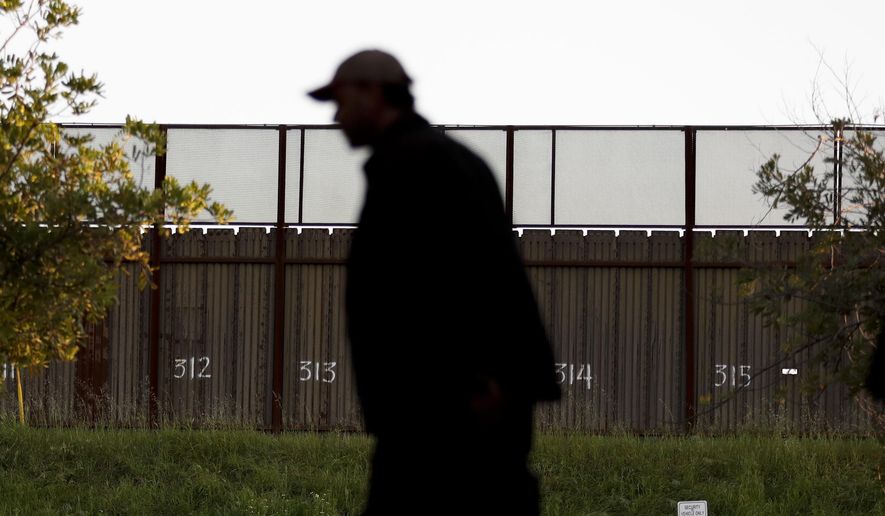Illegal immigration across the southwest border is down more than 60 percent so far under President Trump, officials revealed Tuesday, even before the first new agent is hired or the first mile of his promised border wall is constructed.
Mr. Trump took a victory lap over the “record reductions” in illegal crossers, saying he is already saving Americans’ jobs by preventing them from having to compete with unauthorized workers.
“Down 61 percent since inauguration. Gen. Kelly is doing a fantastic job,” Mr. Trump told a labor union gathering in Washington, praising Homeland Security Secretary John F. Kelly, a retired Marine Corps general.
Mr. Kelly is scheduled to detail the numbers Wednesday to the Senate Homeland Security Committee, which is investigating the situation on the border.
Testifying to the committee in a first hearing Tuesday, former Border Patrol Chief David V. Aguilar said the percentage may be even higher than Mr. Trump teases. Compared with 2016, he said, apprehensions on the southwest border were down 67 percent through March.
Mr. Aguilar credits Mr. Trump, who has freed U.S. Immigration and Customs Enforcement agents to pursue illegal immigrants in the interior of the U.S. and vowed to tighten border controls.
PHOTOS: Top .45-caliber handguns for home defense
“This administration has said we’re going to address illegal immigration. ICE has started working in the interior, unlike other times. So that message resonates,” Mr. Aguilar said.
The numbers were announced just hours before the deadline for the first round of proposals for prototypes of Mr. Trump’s border wall.
Homeland Security is asking for a 30-foot fence that can withstand up to four hours of cutting, blowtorching or other attempts to break through the barrier. Concrete walls and fencing are being sought, and companies selected will build prototypes that will be tested in San Diego.
The early successes of Mr. Trump’s get-tough approach, however, are sparking questions about whether a wall is really needed.
Sen. Claire McCaskill, Missouri Democrat, said the Homeland Security Department has siphoned $20 million away from its technology fund to pay for the initial wall prototypes.
She said early estimates from the department call for $2.6 billion to build less than 75 miles of the wall next year — an average of about $35 million per mile. That is seven times the average cost of existing parts of the wall.
PHOTOS: Best combat rifles of all time
Sen. Heidi Heitkamp, North Dakota Democrat, said she has not found any border official who says a wall along the entire southwestern boundary with Mexico is needed.
“No one, not one person, no matter what political persuasion,” she said. “I just wish we could get beyond that so we can actually talk about what we need to do on the border.”
Mr. Aguilar and Ronald S. Colburn, a former deputy chief of the Border Patrol, said technology is the most important factor in securing the border — but both said barriers do help.
Mr. Colburn, who headed the Border Patrol’s Yuma sector in southwestern Arizona and southeastern California, recounted the differences before and after barriers were built along the sector’s 125-mile border with Mexico. Before, he said, agents arrested 138,000 illegal immigrants, recorded more than 2,700 attempts to barrel across the border in vehicles and seized nearly 36,000 pounds of drugs.
The year after the fence was completed, more agents were deployed and technology was added, they saw just six vehicle attempts — all of which were stopped. The number of apprehensions dropped to about 8,400.
“Ask the Border Patrol agents in the field — they know,” Mr. Colburn said. “When I ask them about fence, every one of them responds yes, build new barriers where needed.”
He said the barriers also made communities in Mexico safer. Before the fence was built, bandits roamed freely, preying on the migrants, often in collusion with human smugglers. Robberies, beatings, rapes and killings were common.
Mr. Colburn said his agents recorded 200 attacks, with 1,800 victims, the year before the fence. That number dropped to zero after the fence.
The number of assaults on Border Patrol agents also declined drastically, he said.
Border officials have long tried to figure out ways to carry Yuma’s successes to the rest of the southwest border and appeared to have made progress through 2012. But a surge of illegal immigrants from Central America, pushed by rough conditions at home and enticed by law policies in the U.S., sent the totals soaring again.
Now, Mr. Trump appears to have reduced those numbers, judging by Border Patrol apprehensions. Analysts say the number of people caught is a rough yardstick for how many people are trying and getting through — so fewer apprehensions means a lower level of illegal immigration.
Mr. Aguilar said similar drops occurred during the Reagan administration after Congress passed a broad amnesty granting legal status to millions of illegal immigrants and promised to get tough on enforcement.
The legalization followed, but not the tough enforcement. Illegal immigration soared in the ensuing 20 years.
“It doesn’t hold for long unless those substantive actions continue,” Mr. Aguilar said.
• Stephen Dinan can be reached at sdinan@washingtontimes.com.




Please read our comment policy before commenting.